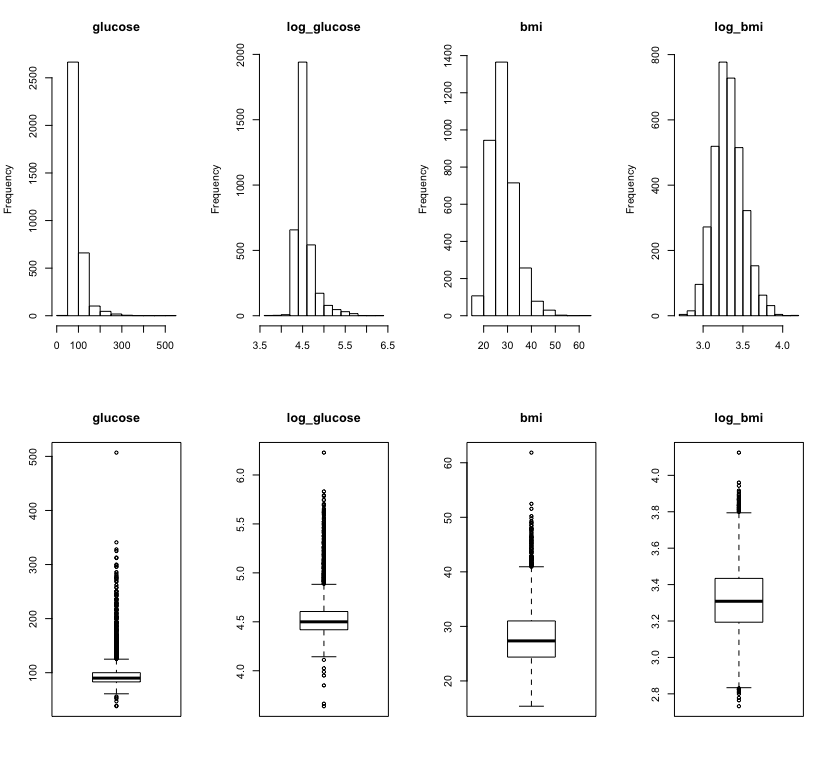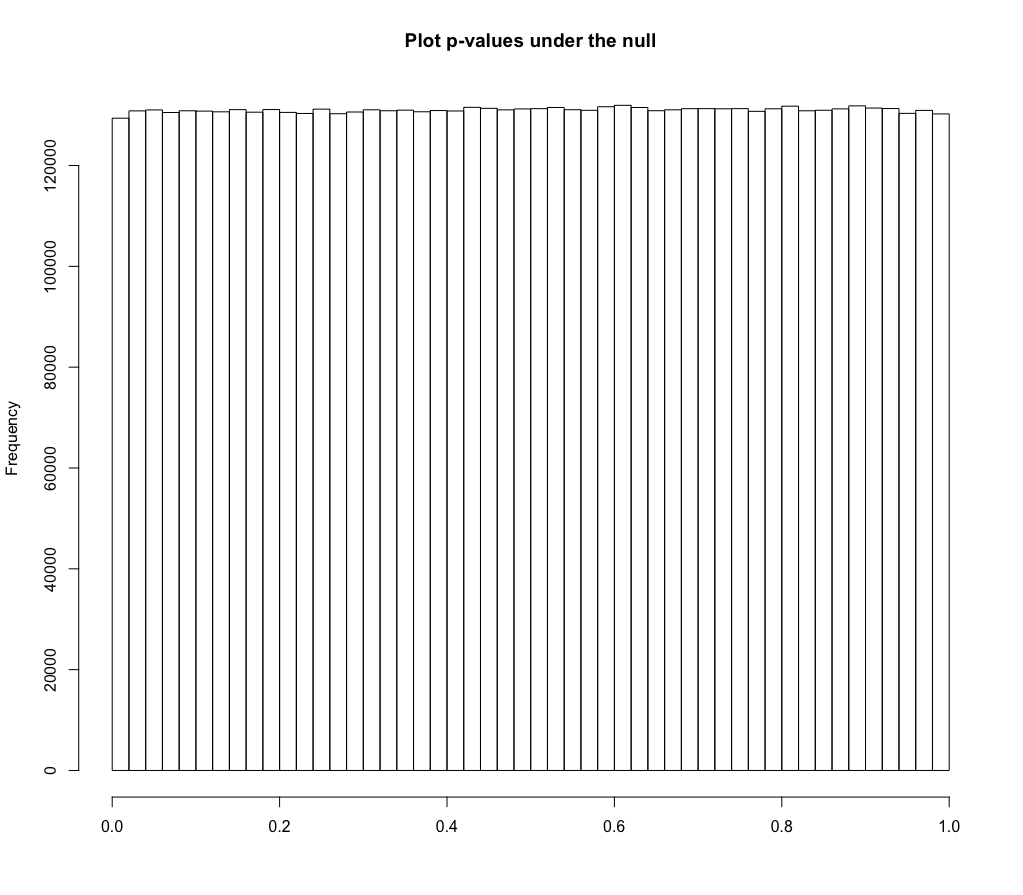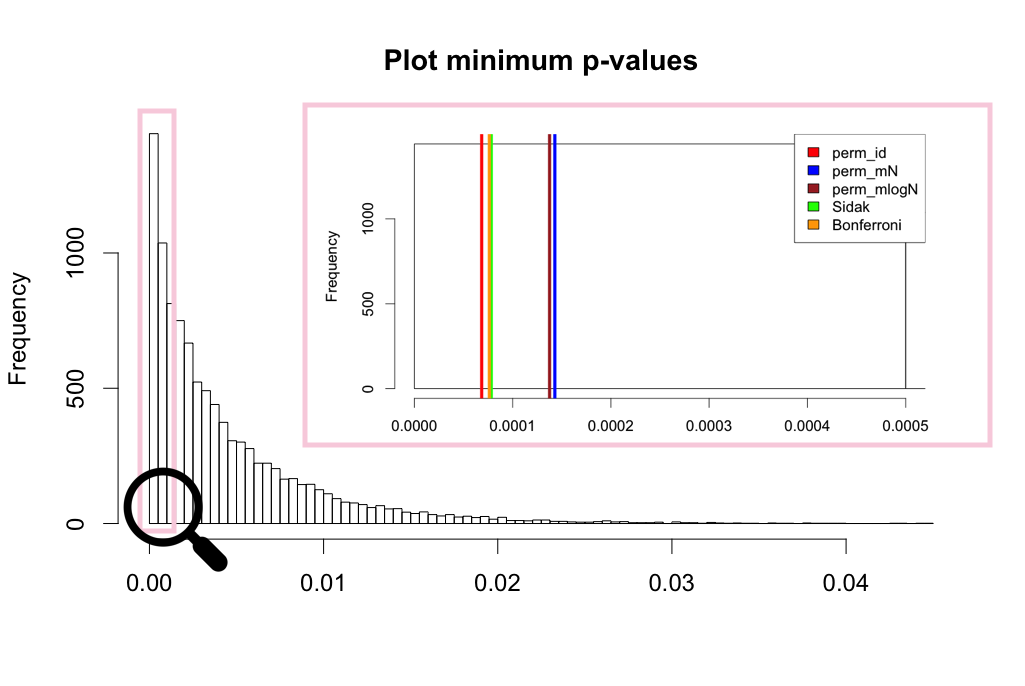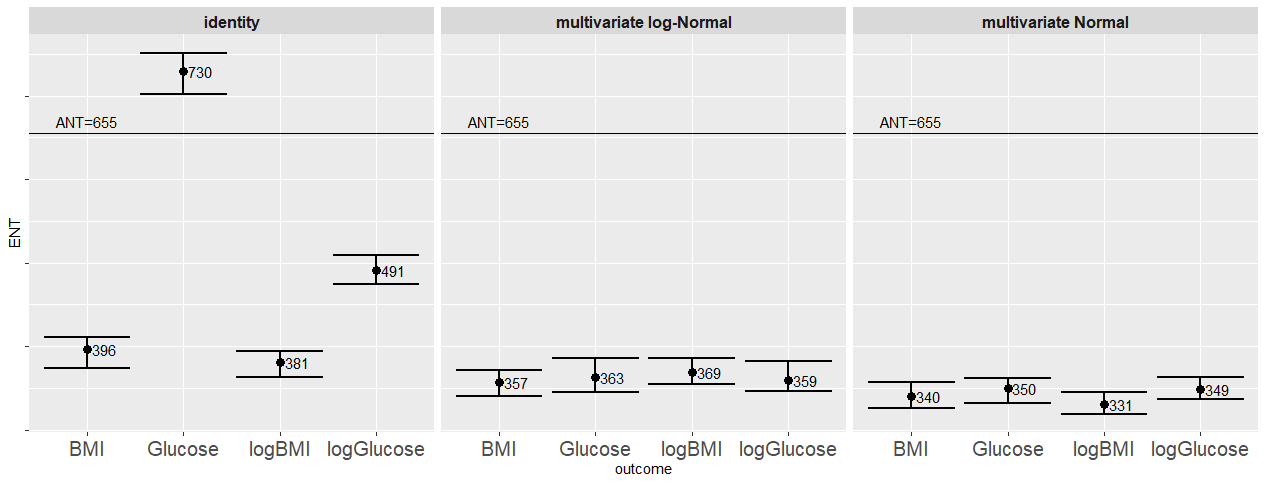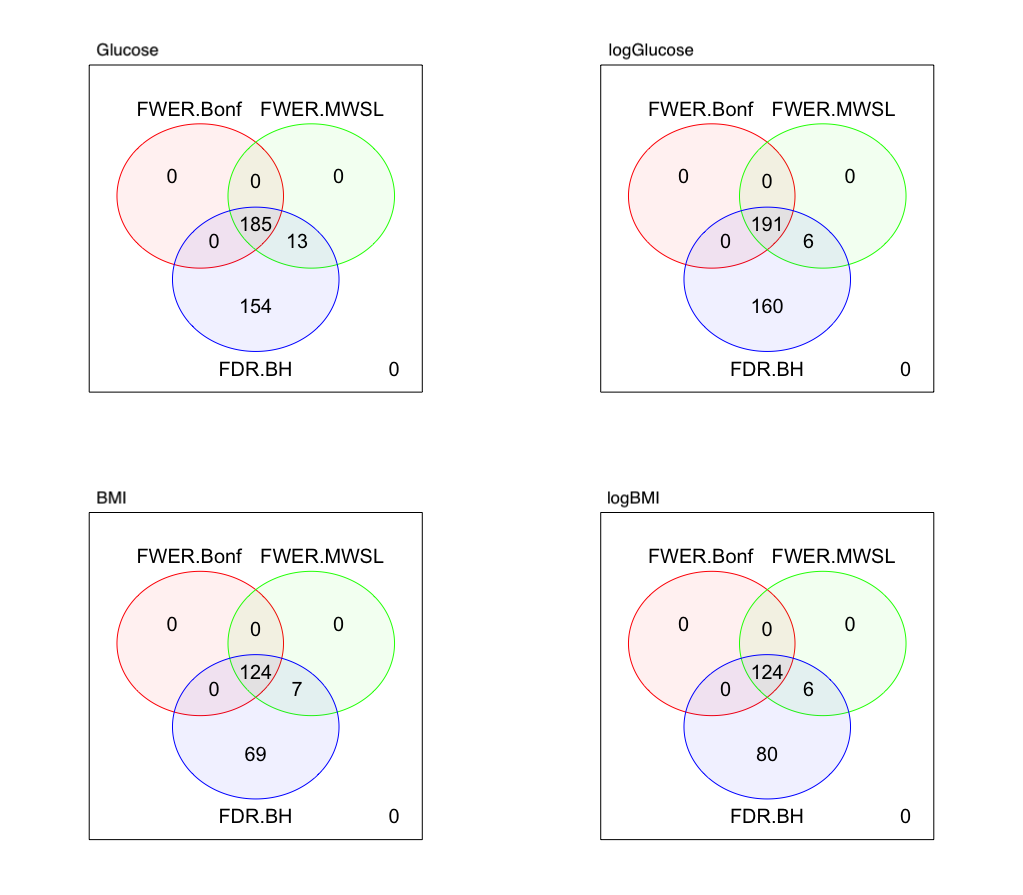PhenoMeNal (Phenome and Metabolome aNalysis) - processing and analysis of molecular phenotype data generated by metabolomics applications
Permutation-based and closed-form-expression tools for the estimation of metabolome-wide significance level (MWSL) and corresponding effective number of tests for (correlated) metabolomics data.
The MWSL R package allows for
- Estimation of permutation-based MWSL and corresponding effective number of tests (ENT)
- Estimation of closed-form-expression MWSL and corresponding effective number of tests (Meff)
- Identification of differentially regulated metabolomics variates for a specific clinical outcome
devtools::install_github("AlinaPeluso/PhenoMeNal", subdir="MWSL")
library(MWSL)
We aim to investigate the association between human serum 1H NMR metabolic profiles and various clinical outcomes in the Multi-Ethnic Study of Atherosclerosis (MESA).
The reference paper considers three sets of NMR spectra data: (1) a standard water-suppressed one-dimensional spectrum (NOESY), and (2) a Carr-Purcell-Meiboom-Gill spectrum (CPMG), and (3) a lower resolution version of the CPMG data (BINNED). The BINNED version consists of M = 655 features, while the NOESY and CPMG contain M = 30,590 features. The BINNED data sample comprises of n = 3500 individuals, while the NOESY and CPMG data have n = 3,867 individuals.
To illustrate the package capabilities, here we reproduce the results for the BINNED version of the data.
data("MESA_binned")
For this specific analysis the metabolomics variates are anonimised and simply referred to as V1,V2,...,V655.
features <- MESA_binned[,23:(ncol(MESA_binned)-1)]
Descriptive statistics of the metabolomics variates:
t(round(sapply(features, function(x) c(mean=mean(x),sd=sd(x),median=median(x),min=min(x),max=max(x))),2))
| feature | mean | sd | median | min | max |
|---|---|---|---|---|---|
| V1 | 0.13 | 0.98 | 0.03 | -2.44 | 5.33 |
| V2 | 0.15 | 0.78 | 0.05 | -1.66 | 3.73 |
| V3 | 0.05 | 0.95 | 0.02 | -3.17 | 3.83 |
| V4 | 2.85 | 0.99 | 2.79 | 0.04 | 6.38 |
| V5 | 1.75 | 0.99 | 1.73 | -2.29 | 5.85 |
| … | … | … | … | … | … |
| V651 | 0.04 | 1.01 | 0.03 | -7.21 | 4.25 |
| V652 | 0.01 | 1.01 | 0.04 | -6.48 | 4.63 |
| V653 | 0 | 1.01 | 0.03 | -4.81 | 5.51 |
| V654 | 0.03 | 1.01 | 0.03 | -3.74 | 4.08 |
| V655 | 0.02 | 1.01 | 0.03 | -4.09 | 4.54 |
Briefly, the cohort includes participants (51% females, 49% males), aged 44-84 years, (mean age of 63 years) from four different ethnic groups: Chinese-American, African-American, Hispanic, and Caucasian, all recruited between 2000-2002 at clinical centres in the United States and free of symptomatic cardiovascular disease at baseline. Demographic, medical history, anthropometric, and lifestyle data, as well as serum samples were collected, together with information on diabetes, and lipid and blood pressure treatment.
MESA_binned$male <- ifelse(MESA_binned$sex<2,1,0)
confounders <- MESA_binned[,c("age","male","height","ethnicityH","ethnicityAA","ethnicityCA","smokingF","smokingC","ldl_chol","hdl_chol","sbp","bp_treatment","diabetes","lipids_treatment")]
Descriptive statistics of the clinical outcomes measures:
t(round(sapply(MESA_binned[,c(7,9:22,ncol(MESA_binned))], function(x) c(mean=mean(x),sd=sd(x),median=median(x),min=min(x),max=max(x))),3))
| confounder | mean | sd | median | min | max |
|---|---|---|---|---|---|
| age | 62.888 | 10.327 | 64 | 44 | 84 |
| height | 166.433 | 10.237 | 166.3 | 123.8 | 196.7 |
| ethnicityC | 0.385 | 0.487 | 0 | 0 | 1 |
| ethnicityH | 0.234 | 0.424 | 0 | 0 | 1 |
| ethnicityAA | 0.255 | 0.436 | 0 | 0 | 1 |
| ethnicityCA | 0.127 | 0.333 | 0 | 0 | 1 |
| smokingN | 0.503 | 0.5 | 1 | 0 | 1 |
| smokingF | 0.121 | 0.326 | 0 | 0 | 1 |
| smokingC | 0.376 | 0.485 | 0 | 0 | 1 |
| ldl_chol | 117.678 | 31.043 | 116 | 20 | 315 |
| hdl_chol | 51.3 | 14.42 | 49 | 21 | 133 |
| sbp | 126.922 | 21.54 | 124 | 77 | 218 |
| bp_treatment | 0.376 | 0.484 | 0 | 0 | 1 |
| diabetes | 0.135 | 0.342 | 0 | 0 | 1 |
| lipids_treatment | 0.167 | 0.373 | 0 | 0 | 1 |
| male | 0.489 | 0.5 | 0 | 0 | 1 |
The outcomes of interest are glucose concentrations and the body mass index or BMI.
glucose <- MESA_binned[,1]; log_glucose <- MESA_binned[,2]; bmi <- MESA_binned[,7]; log_bmi <- MESA_binned[,8];
outcomes <- MESA_binned[,c(1:4)]
Descriptive statistics of the clinical outcomes measures:
t(round(sapply(MESA_binned[,c(1:4)], function(x) c(mean=mean(x),sd=sd(x),median=median(x),min=min(x),max=max(x))),2))
| outcome | mean | sd | median | min | max |
|---|---|---|---|---|---|
| glucose | 97.55 | 29.6 | 90 | 38 | 507 |
| logGlucose | 4.55 | 0.22 | 4.5 | 3.64 | 6.23 |
| BMI | 28.14 | 5.39 | 27.34 | 15.36 | 61.86 |
| logBMI | 3.32 | 0.18 | 3.31 | 2.73 | 4.12 |
Plot of the distributions of the clinical outcomes measures:
par(mfrow=c(2,4))
for (i in 1:ncol(outcomes)){hist(outcomes[,i],main=names(outcomes)[i],xlab=NULL)}
for (i in 1:ncol(outcomes)){boxplot(outcomes[,i],main=names(outcomes)[i],xlab=NULL)}
MWSL::FWERperm performs the estimation of permutation-based metabolome-wide significance level (MWSL) and the corresponding effective number of tests (ENT). The procedure controls the FWER at the α level. The type I error rate (false-positive rate) is measured as the number of occurrences of having a p-value less or equal than the MWSL, that is when a true null hypothesis is being rejected.
Arguments:
outcomea vector ofndata point values of a continuous (both symmetric and skewed), discrete binary (0/1) or count outcome, or a data frame withnobservations and column variablestime(ortime1andtime2) andstatusfor a time-to-event survival outcome.featuresa data frame ofnobservations (rows) andMfeatures e.g. metabolic profiles (columns).confoundersan optional data frame ofnobservations (rows) andPfixed effects confounders (columns). Default toconfounders=NULL.methodsan optional string which can take values'identity'if no transformation is applied to the data, or'mN'(or'mlogN') when the set of features is simulated via a multivariate Normal (or multivariate log-Normal) distribution. Default tomethods='mN'.n.permutationan optional numeric value. Default ton.permutation=10,000.alphaan optional probability value. Default toalpha=0.05.verbosean optional logical value which allows output some status messages while computing. Default toverbose=TRUE.
Outputs:
matPvalsthe matrix of p-values for theMfeatures (columns) and then.permutation(rows).qthe vector of minimum p-values of lengthn.permutation.resthe vector of result estimates:MWSL= metabolome-wide significance level (MWSL);MWSL_CI.up= upper valuealpha%-confidence interval MWSL;MWSL_CI.low= lower valuealpha%-confidence interval MWSL.ENT= effective number of tests (ENT);ENT_CI.up= upper valuealpha%-confidence interval ENT;ENT_CI.low= lower valuealpha%-confidence interval ENT;R.percent= ENT/M.
t1err.percentthe estimated type I error (%).
Optimal performances in terms of computational time are achieved when the procedure runs on a multi-core computer as parallel computing is applied within the function to deal with the heaviest steps.
Run the function across the clinical outcomes measures:
methods <- c('identity','mN','mlogN')
mat <- matrix(NA,3,8)
colnames(mat) <- c('MWSL','MWSL_CI.up','MWSL_CI.low','ENT','ENT_CI.up','ENT_CI.low','R.percent','t1err.percent')
rownames(mat) <- methods
rmesa_FWERperm <- list(glucose=mat,log_glucose=mat,bmi=mat,log_bmi=mat)
rmesa_pval <- list(glucose=mat,log_glucose=mat,bmi=mat,log_bmi=mat)
rmesa_FWERperm <- list(glucose=mat,log_glucose=mat,bmi=mat,log_bmi=mat)
allres_mesa <- list()
for (j in 1:length(methods)){
for (i in 1:ncol(outcomes)){
rmesa <- FWERperm(outcome=outcomes[,i],
features=features,
confounders=confounders,
n.permutation=60,
method=methods[j],
verbose=F)
allres_mesa[[3*(i-1)+j]] <- rmesa
rmesa_FWERperm[[i]][j,1:7] <- rmesa$res
rmesa_FWERperm[[i]][j,8] <- rmesa$t1err.percent
}
}
df.names <- expand.grid(methods, names(outcomes))
names(allres_mesa) <- paste(df.names$Var1, df.names$Var2,sep='.')
Explore the results:
rmesa_FWERperm
glucose
| MWSL | MWSL_CI.up | MWSL_CI.low | ENT | ENT_CI.up | ENT_CI.low | R.percent | t1err.percent | |
|---|---|---|---|---|---|---|---|---|
| identity | 0.0000685 | 0.0000665 | 0.0000713 | 729.803 | 751.496 | 701.647 | 111.42 | 4.95 |
| mN | 0.0001430 | 0.0001380 | 0.0001508 | 349.737 | 362.19 | 331.658 | 53.39 | 4.97 |
| mlogN | 0.0001376 | 0.0001296 | 0.0001447 | 363.358 | 385.699 | 345.604 | 55.47 | 5.14 |
logGlucose
| MWSL | MWSL_CI.up | MWSL_CI.low | ENT | ENT_CI.up | ENT_CI.low | R.percent | t1err.percent | |
|---|---|---|---|---|---|---|---|---|
| identity | 0.0001018 | 0.0000982 | 0.0001053 | 491.344 | 508.917 | 474.867 | 75.01 | 5.06 |
| mN | 0.0001434 | 0.0001378 | 0.0001483 | 348.567 | 362.855 | 337.154 | 53.22 | 5.07 |
| mlogN | 0.0001392 | 0.0001310 | 0.0001442 | 359.09 | 381.818 | 346.816 | 54.82 | 4.98 |
BMI
| MWSL | MWSL_CI.up | MWSL_CI.low | ENT | ENT_CI.up | ENT_CI.low | R.percent | t1err.percent | |
|---|---|---|---|---|---|---|---|---|
| identity | 0.0001262 | 0.0001216 | 0.0001335 | 396.188 | 411.0372 | 374.544 | 60.49 | 5.18 |
| mN | 0.0001470 | 0.0001401 | 0.0001534 | 340.142 | 357.0032 | 325.845 | 51.93 | 5.20 |
| mlogN | 0.0001402 | 0.0001345 | 0.0001468 | 356.707 | 371.7413 | 340.712 | 54.46 | 5.00 |
logBMI
| MWSL | MWSL_CI.up | MWSL_CI.low | ENT | ENT_CI.up | ENT_CI.low | R.percent | t1err.percent | |
|---|---|---|---|---|---|---|---|---|
| identity | 0.0001313 | 0.0001266 | 0.0001377 | 380.688 | 394.8619 | 363.169 | 58.12 | 5.08 |
| mN | 0.0001512 | 0.0001447 | 0.0001567 | 330.715 | 345.6358 | 319.064 | 50.49 | 5.12 |
| mlogN | 0.0001356 | 0.0001296 | 0.0001410 | 368.722 | 385.7733 | 354.6 | 56.29 | 4.92 |
The permutation procedure provides strong control of the FWER at the α level set it to 5% while it also incorporates the joint dependence structure between the test statistics.
We can inspect the distribution of p-values corresponding to the case where the multivariate Normal distribution is employed to simulate the set of features
hist(allres_mesa[["mN.glucose"]][["matPvals"]],main="Plot p-values under the null",breaks=50,xlab=NULL)
The p-values have a uniform distribution as we have re-sampled under the true null hypothesis of no association.
We can also inspect the distribution of the minimum p-values corresponding to the case where the multivariate Normal distribution is employed to simulate the set of features
hist(allres_mesa[["mN.glucose"]][["q"]],main="Plot minimum p-values",breaks=150,xlab=NULL)
op <- par(cex = 1.5); alpha=0.05
abline(v=rmesa_FWERperm$glucose[1,1],col="red",lwd=5)
abline(v=rmesa_FWERperm$glucose[2,1],col="blue",lwd=5)
abline(v=rmesa_FWERperm$glucose[3,1],col="brown",lwd=5)
abline(v=1-(1-alpha)^(1/ncol(features)),col="green",lwd=5)
abline(v=alpha/ncol(features),col="orange",lwd=5)
legend("topright",c('perm_id','perm_mN','perm_mlogN','Sidak','Bonferroni'),fill=c("red","blue","brown","green","orange"))
The procedure is less conservative than the Bonferroni or Sidak correction.
Plot of the ENT estimates from the permutation procedure:
df_rmesa_FWERperm <- do.call(rbind,rmesa_FWERperm)
df1_rmesa_FWERperm<- data.frame(
outcome = c('glucose','glucose','glucose',
'logGlucose','logGlucose','logGlucose',
'BMI','BMI','BMI',
'logBMI','logBMI','logBMI'),
type = c('identity','multivariate Normal','multivariate log-Normal',
'identity','multivariate Normal','multivariate log-Normal',
'identity','multivariate Normal','multivariate log-Normal',
'identity','multivariate Normal','multivariate log-Normal'),
ENT = c(df_rmesa_FWERperm[,4]),
ENT.ciUP = c(df_rmesa_FWERperm[,5]),
ENT.ciLOW = c(df_rmesa_FWERperm[,6]))
(plot_res.MESA_co <- ggplot(data=df1_rmesa_FWERperm,aes(x=outcome,y=ENT)) +
facet_grid(~ type) +
geom_hline(yintercept=ncol(features)) +
annotate("text",x='BMI',y=(ncol(features)+15),label='ANT=655') +
geom_text(mapping=aes(label=round(ENT,0)),hjust=-.5)+
geom_point(size=3) +
geom_errorbar(aes(ymin=ENT.ciLOW,ymax=ENT.ciUP),size=1) +
theme(text = element_text(size=20)) +
theme(legend.position="bottom") +
theme(axis.text.x = element_text(angle=30, hjust=1)) +
theme(axis.text.y = element_blank()) +
ggtitle("MESA_binned data - all clinical outcomes")
)
From the conventional permutation procedure applied to the BINNED data, when the real features are considered, there is instability in the estimation of the ENT across the different outcomes, and in particular the ENT estimate for glucose is above the ANT. When the feature data are simulated from a multivariate log-Normal or Normal distribution, the ENT estimates are stable across the different outcomes and remain bounded below the total number of features with an average ENT of 352 and an R ratio of 53.8%.
The empirical method of computing the permutation test p-value is hampered by the fact that a very large number of permutation is required to correctly estimate small, and therefore interesting p-values. Thus, the MWSL::Meff allows for an efficient approximation alternative. To distinguish from the effective number of non-redundant variates from the permutation procedure which has been defined as ENT, here we refer to the estimate from this practical approximation approach as Meff. The approximation is based on the spectral decomposition of the correlation matrix of the metabolomics variates, and allows for the comparison of the proposed estimate with methods of interest from the genomics field which proposed a similar formulation based on the same concept.
Arguments:
featuresa data frame ofnobservations (rows) andMfeatures e.g. metabolic profiles (columns).methodsa string with possible valuesecorr(empirical correlation), orscorr(shrinkage correlation). Default toecorr.alphaan optional probability value. Default toalpha=0.05.big.matan optional logic value to be set toTRUEwhen dealing with a very large set of features. Default toFALSE.
Outputs:
Meff_Nyholtclosed-form expression of the effective number of tests based on Nyholt (2004)Meff_Lijiclosed-form expression of the effective number of tests based on Li & Ji (2005)Meff_Gaoclosed-form expression of the effective number of tests based on Gao (2008)Meff_Galweyclosed-form expression of the effective number of tests based on Galwey (2009)Meff_Bonferroniclosed-form expression of the effective number of tests based on Bonferroni (1963)Meff_Sidakclosed-form expression of the effective number of tests based on Sidak (1967)Meff_MWSLthe proposed closed-form expression of the effective number of testsres.Meff_MWSLthe vector of result estimates:MWSL= metabolome-wide significance level (MWSL);MWSL_CI.up= upper valuealpha%-confidence interval MWSL;MWSL_CI.low= lower valuealpha%-confidence interval MWSL.ENT= effective number of tests (ENT);ENT_CI.up= upper valuealpha%-confidence interval ENT;ENT_CI.low= lower valuealpha%-confidence interval ENT;R.percent= ENT/M.
Run the function:
rmesa_Meff_ecorr <- Meff(features=features,
n.permutation=100000,
method='ecorr',
big.mat=FALSE,
alpha=0.05)
Explore the results:
mat.rmesa_Meff_ecorr <- rbind(Meff_Nyholt=rmesa_Meff_ecorr$Meff_Nyholt,
Meff_Liji=rmesa_Meff_ecorr$Meff_Liji,
Meff_Gao=rmesa_Meff_ecorr$Meff_Gao,
Meff_Galwey=rmesa_Meff_ecorr$Meff_Galwey,
Meff_Bonferroni=rmesa_Meff_ecorr$Meff_Bonferroni,
Meff_Sidak=rmesa_Meff_ecorr$Meff_Sidak,
Meff_MWSL=rmesa_Meff_ecorr$Meff_MWSL);
mat.rmesa_Meff_ecorr
| Method | Estimate | R(%) |
|---|---|---|
| Meff_Nyholt | 611 | 93% |
| Meff_Liji | 226 | 35% |
| Meff_Gao | 435 | 66% |
| Meff_Galwey | 201 | 31% |
| Meff_Bonferroni | 655 | 100% |
| Meff_Sidak | 639 | 98% |
| Meff_MWSL | 345 | 53% |
| ENT | 352 | 54% |
The closed-form Meff value is a good approximation of the ENT estimate from the permutation procedure.
The MWSL estimate can be access as
rmesa_Meff_ecorr$res.Meff_MWSL
| MWSL | MWSL_CI.up | MWSL_CI.low | ENT_MWSL | ENT_MWSL_CI.up | ENT_MWSL_CI.low | R.percent |
|---|---|---|---|---|---|---|
| 0.000145102 | 0.000147141 | 0.000142823 | 344.5863 | 350.0843 | 339.8103 | 52.61% |
This section focus on identification of differentially regulated metabolomics variates directly linked to a specified outcome (e.g. disease risk). The procedure supports various outcome type i.e. continuous outcomes both symmetric and skewed, binary (0/1) outcome, countable outcome taking discrete values 0,1,2,3,$...$, as well as a survival time-to-event outcome.
| Outcome type | Model | R function |
|---|---|---|
| continuous (symmetric) | OLS regression | stats::lm |
| continuous (skewed) | Median quantile regression | quantreg::rq(tau=.5) |
| binary (0/1) | Logistic regression | stats::glm(family="binomial") |
| count (equidispersed) | GLM Poisson regression | stats::glm(family="poisson") |
| count (overdispersed) | Negative Binomial regression | glm(family="negative.binomial") |
| survival (time-to-event) | Cox proportional hazards regression | survival::coxph |
Once the appropriate analysis has been performed the metabolites of interest can be identified comparing the respective p-value to the the adjusted thresold (MWSL or Meff). When the raw p-value corresponding to a certain feature is smaller than the adjusted thresold we identify that metabolomic variate as significant. For the other metabolites we conclude that there is no association between the changes in the outcome variable and the shifts in these features.
Arguments:
outcomea vector ofndata point values of a continuous (both symmetric and skewed), discrete binary (0/1) or count outcome, or a data frame withnobservations and column variablestime(ortime1andtime2) andstatusfor a time-to-event survival outcome.featuresa data frame ofnobservations (rows) andMfeatures e.g. metabolic profiles (columns).confoundersan optional data frame ofnobservations (rows) andPfixed effects confounders (columns). Default toconfounders=NULL.MWSLmetabolome-wide significance level (MWSL) estimated via the permutation-based approach (seeMWSL::FWERperm) or via the via the closed-form-expression approach (seeMWSL::Meff)alphaan optional probability value, default=0.05vennPlotan optional logic value to be set toTRUEfor the visualisation of the Venn-plot for the total count of differrentally regulated metabolomics variates when employing the Bonferroni, the Benjamini-Hochberg (FDR), and the MWSL (FWER) correction, respectivelyverbosean optional logic value to suppress some output status messages. Default toTRUE.
Outputs:
res.DE_counttotal count of differrentally regulated metabolomics variates when employing the Bonferroni, the Benjamini-Hochberg (FDR), and the MWSL (FWER) correction, respectively.res.DE_namesnames of the of differrentally regulated metabolomics variates when employing the Bonferroni, the Benjamini-Hochberg (FDR), and the MWSL (FWER) correction, respectively.Venn_plot Venn-plotvisualisation tool for the total count of differrentally regulated metabolomics variates when employing the Bonferroni, the Benjamini-Hochberg (FDR), and the MWSL (FWER) correction, respectively.
Run the function for all the clinical outcomes measures:
rmesa_DEtest <- rmesa_DEtest_count <- list()
names(rmesa_DEtest) <- c('glucose','logGlucose','BMI','logBMI')
for (i in 1:ncol(outcomes)){
res_DEtest <- DEtest(outcome=outcomes[,i],
features=features[,1:10],
confounders=confounders,
MWSL=0.000145102,
alpha=0.05,
vennPlot=TRUE)
rmesa_DEtest[[i]]<- res_DEtest
rmesa_DEtest_count[[i]]<- res_DEtest$res.DE_count
}
Explore the results:
A Venn plot is generated for the visualisation of the number of identified differentially regulated metabolomics variates when employing the Bonferroni, the Benjamini-Hochberg (BH, FDR), and the MWSL (FWER) correction.
The counts of the differentially regulated metabolomics variates for each clinical outcomes can be accessed as
res.mesa_DEtest_count <- do.call(rbind, rmesa_DEtest_count)
rownames(res.mesa_DEtest_count) <- c('glucose','logGlucose','BMI','logBMI')
res.mesa_DEtest_count
| FWER.Bonf | FWER.MWSL | FDR.BH | |
|---|---|---|---|
| glucose | 185 | 198 | 352 |
| logGlucose | 191 | 197 | 357 |
| BMI | 124 | 131 | 200 |
| logBMI | 124 | 130 | 210 |
The FWER approach based on the MWSL estimation allows for the identification of a number of differentially regulated variates less than the too liberal BH correction and greater than the highly conservative Bonferroni correction. The number of differentially regulated variates is stable when considering transformations of the clinical outcome measures.
The list of differentially regulated metabolomics variates identified via the MWSL approach for a specific clinical outcome e.g. glucose can be accessed as
rmesa_DEtest[["glucose"]][["res.DE_names"]][["FWER.MWSL"]]
| V1 | V3 | V4 | V8 | V9 | ... | V596 | V597 | V610 | V618 | V619 |
